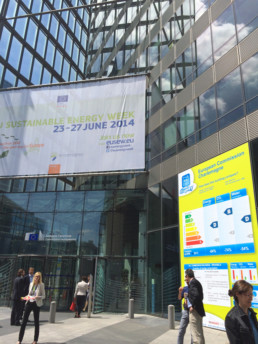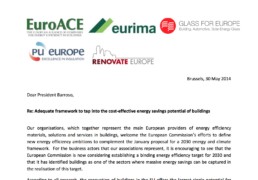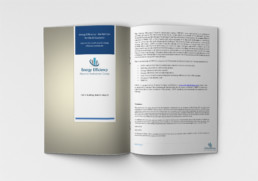Display Poster on the Charlemagne Building during EUSEW!
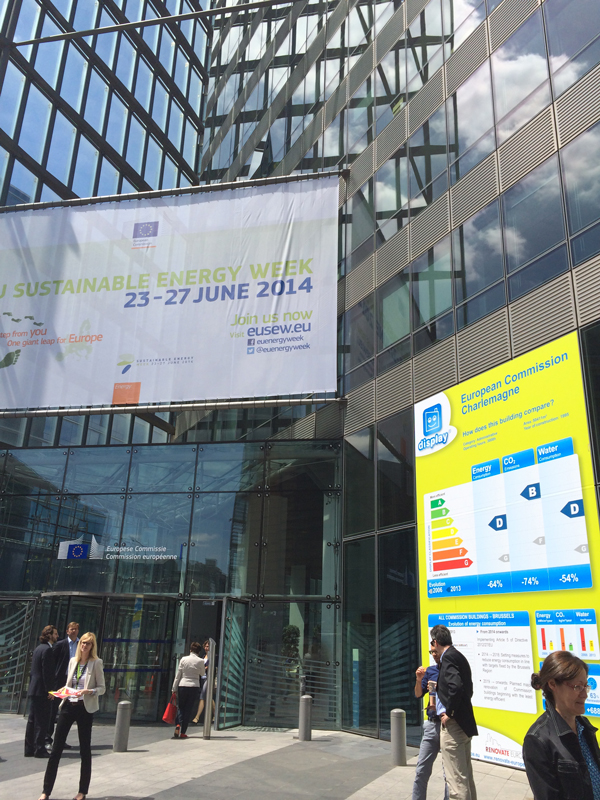 Giant-size Poster on Charlemagne Building reveals energy consumption of Commission buildings
Giant-size Poster on Charlemagne Building reveals energy consumption of Commission buildings
In partnership with Renovate Europe and Energy Cities, the Commission, though its Office for Infrastructure and Logistics in Brussels (OIB), will partake in a highly visible communication action during the EU Sustainable Energy Week (EUSEW – 23-27 June) by presenting a giant-size Display Campaign poster on the Charlemagne building highlighting the energy consumption of Commission buildings.
“The average energy consumption per square meter for the Commission buildings in Brussels has decreased by more than 30% between 2005 and 2013, which is more than 4% per year, and that is just the beginning!” explained Marc Seguinot, Head of Unit in the OIB, responsible for the management of the Commission's buildings. “Such significant results have encouraged us to go further, and we have planned for major renovation of Commission buildings from 2019. I hope this will inspire other public administrations to follow in the same lead”.
The recently adopted Energy Efficiency Directive (2012/27/EU) requires Member States to renovate 3% every year of their buildings owned and occupied by the central governments. The Commission has committed itself to reach the same result.
“This is a good example of a public administration which has put in place a coherent set of long-term energy efficiency measures to STOP energy waste in its buildings, and has reached a 4% reduction in energy consumption per year,” said Adrian Joyce, Renovate Europe Campaign Director. “The benefits of such energy savings are widespread: they will be felt through a reduced energy bill, but also through improved health and productivity for the buildings’ occupants, so it really is a win-win solution”.
As the EU takes strides towards reducing its energy dependence on foreign imports, Europe’s leaky building stock is increasingly coming under scrutiny, as buildings represent the largest energy consuming sector in the EU at a high of 43% of all energy consumed. It is possible to reduce the energy consumption of a large part of the building stock by 80% with currently available technologies.
“Citizens need to see that public institutions are not paying lip service to the energy transition but actually taking action. Everywhere across Europe, local authorities are driving this trend, with over 500 of them taking part in the Display Campaign. Close to 6,000 cities have committed to adopt ambitious sustainable energy action plans through the Covenant of Mayors, the Display Campaign is a useful communication and transparency initiative to support them along this path”, said Claire Roumet, Deputy Executive Director of Energy Cities.
The giant-size Display poster will be hanging on the Charlemagne building from 20th June until the end of EUSEW on 27th June. The OIB will provide additional information about the Commission’s buildings policy at the EuroACE EUSEW High-Level Policy Event “Quizzing the Stakeholders” on the morning of Wednesday 25th June in the Charlemagne.


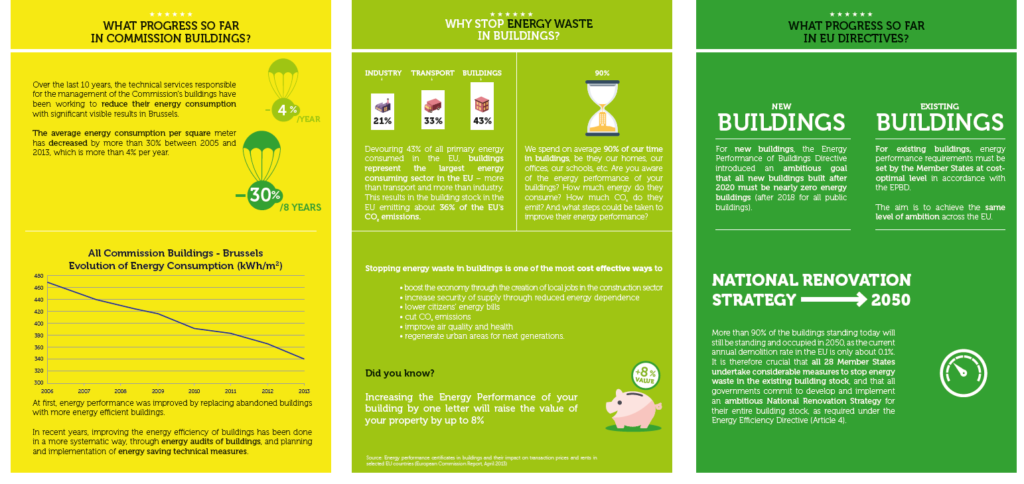
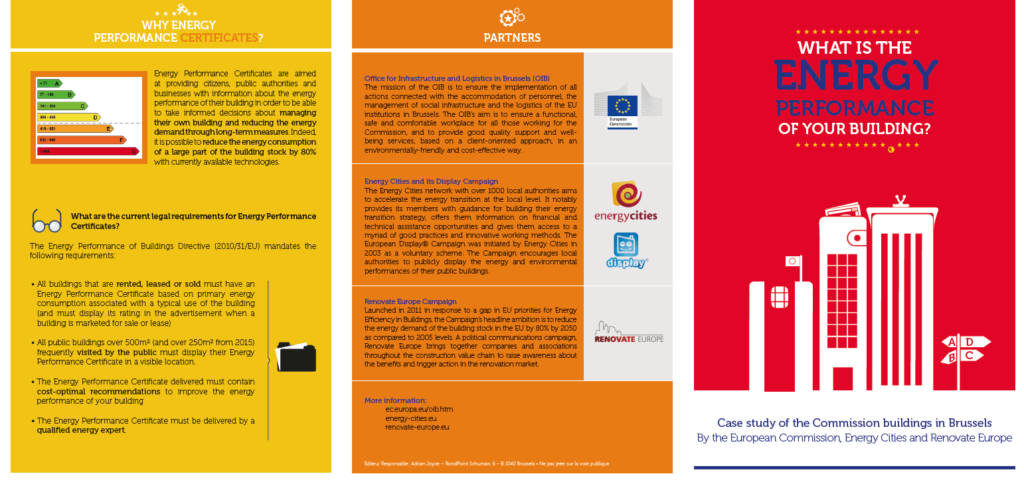
Giant size poster on Charlemagne Building reveals Energy Consumption of Commission buildings
In partnership with Renovate Europe and Energy Cities, the Commission, though its Office for Infrastructure and Logistics in Brussels (OIB), will partake in a highly visible communication action during the EU Sustainable Energy Week (EUSEW – 23-27 June) by presenting a giant-size Display Campaign poster on the Charlemagne building highlighting the energy consumption of Commission buildings.
“The average energy consumption per square meter for the Commission buildings in Brussels has decreased by more than 30% between 2005 and 2013, which is more than 4% per year, and that is just the beginning!” explained Marc Seguinot, Head of Unit in the OIB, responsible for the management of the Commission's buildings. “Such significant results have encouraged us to go further, and we have planned for major renovation of Commission buildings from 2019. I hope this will inspire other public administrations to follow in the same lead”.
The recently adopted Energy Efficiency Directive (2012/27/EU) requires Member States to renovate 3% every year of their buildings owned and occupied by the central governments. The Commission has committed itself to reach the same result.
“This is a good example of a public administration which has put in place a coherent set of long-term energy efficiency measures to STOP energy waste in its buildings, and has reached a 4% reduction in energy consumption per year,” said Adrian Joyce, Renovate Europe Campaign Director. “The benefits of such energy savings are widespread: they will be felt through a reduced energy bill, but also through improved health and productivity for the buildings’ occupants, so it really is a win-win solution”.
As the EU takes strides towards reducing its energy dependence on foreign imports, Europe’s leaky building stock is increasingly coming under scrutiny, as buildings represent the largest energy consuming sector in the EU at a high of 43% of all energy consumed. It is possible to reduce the energy consumption of a large part of the building stock by 80% with currently available technologies.
“Citizens need to see that public institutions are not paying lip service to the energy transition but actually taking action. Everywhere across Europe, local authorities are driving this trend, with over 500 of them taking part in the Display Campaign. Close to 6,000 cities have committed to adopt ambitious sustainable energy action plans through the Covenant of Mayors, the Display Campaign is a useful communication and transparency initiative to support them along this path”, said Claire Roumet, Deputy Executive Director of Energy Cities.
The giant-size Display poster will be hanging on the Charlemagne building from 20th June until the end of EUSEW on 27th June. The OIB will provide additional information about the Commission’s buildings policy at the EuroACE EUSEW High-Level Policy Event “Quizzing the Stakeholders” on the morning of Wednesday 25 th June in the Charlemagne.
Letter to Mr Barroso, President of the European Commission
Dear President Barroso,
Re: Adequate framework to tap into the cost-effective energy savings potential of buildings
Our organisations, which together represent the main European providers of energy efficiency materials, solutions and services in buildings, welcome the European Commission’s efforts to define new energy efficiency ambitions to complement the January proposal for a 2030 energy and climate framework. For the business actors that our associations represent, it is encouraging to see that the European Commission is now considering establishing a binding energy efficiency target for 2030 and that it has identified buildings as one of the sectors where massive energy savings can be captured in the realisation of this target.
According to all research, the renovation of buildings in the EU offers the largest single potential for cost-effective energy savings in short-, medium- and long-term timescales, providing substantial multiple benefits such as job creation and energy security. For the EU to capture this full potential, our industry needs to receive a clear signal that large-scale energy savings will be sought in a long-term perspective. This signal must be unambiguous to avoid short-term sub-optimal solutions being applied that lock-in a large part of the savings potential, thus significantly reducing overall savings.
In this context, the nature and level of energy efficiency targets the European Commission will propose for 2030 will be instrumental.
Our associations urge the European Commission to design targets in a way that reflects the building sector’s contribution in full, following a bottom-up assessment of the real cost-effective energy savings potential in the sector. It is essential that the level of the target is in line with the identified cost- effective energy savings for 2030 so as to put Europe on track to realise its 2050 objectives.
Our associations therefore call on the European Commission to ensure that its target proposal includes a specific signal to the building and construction materials industries for the needed mobilisation and long-term planning and investment in this fragmented sector to happen. In our view, the most effective signal should take the form of a sectoral target for buildings as a complement to overall energy efficiency ambitions. Such a target will give credibility to the stated political objectives of the European Commission and is essential to equip stakeholders with the necessary tool to prioritise the realisation of our full savings potential.
The proper formulation of energy efficiency targets for 2030 is of crucial importance, hence our desire to avoid the pitfalls of having only an overall general target that would fail to address the full potential
of the buildings sector. Such a situation will promote “business-as-usual” and thus send the wrong signal to our industry. We therefore count on your willingness to prioritise the buildings sector to set the right framework conditions for a mobilised construction industry to deliver on the promise of massive energy savings.
Yours sincerely,
| Bertrand Cazes
Secretary General Glass for Europe |
Susanne Dyrboel
President EuroACE |
Adrian Joyce
Campaign Director Renovate Europe |
| Oliver Loebel
Managing Director PU Europe |
Jan te Bos Director General
EURIMA |
Recipients:
College of Commissioners
European Commission Secretary-General, Catherine Day
DG Energy Director General, Dominique Ristori
European Parliament stands strong on Energy Efficiency: Over 100 MEPs pledge to STOP Energy Waste in Buildings in their 2014-2019 mandate
The Renovate Europe Manifesto for the 2014 Elections has received over 100 signatures from sitting and candidate MEPs, who have pledged to keep Energy Efficiency in Buildings high on the political agenda if re-elected in the next legislative term. Among these signatures are MEPs from 19 different European countries, from all 5 main European political parties as well as 5 EP Vice-Presidents.
“Having over 100 MEPs sign the Renovate Europe Manifesto, more precisely the pledge it contains, indicates that the prospective incoming MEPs are keen for the EP to maintain its supportive role in favour of Energy Efficiency in Buildings”, explained Adrian Joyce, RE Campaign Director. “The 2009-2014 EP demonstrated leadership on the issue by calling for a reduction of the energy demand of the EU’s buildings stock by 80% by 2050 in two of its reports (2030 Policy Framework for Climate and Energy and the 2050 Energy Roadmap). At a time when citizens are looking for sustainable long-term solutions with tangible benefits for the economy, I am pleased to see that the incoming EP will work to STOP Energy Waste in Buildings”.
Reducing the energy demand of the EU building stock provides an affordable and long-term solution to rising energy prices and energy dependence and has the potential to create millions of local, non-exportable jobs, in addition to providing an economic boost to the depressed construction sector and SMEs across the EU.
The Renovate Europe Manifesto urges MEPs to undertake the following actions if elected for the next mandate:
- Urge their National government to implement an ambitious national renovation strategy
- Hold the relevant commissioners and commission service to account on the importance of taking action for Buildings renovation.
- Establish continuous dialogue with and support for local authorities in their efforts to Renovate the EU building stock
- Recall that Energy Efficiency buildings renovation requires high prioritisation at political and legislative levels
- Help to disseminate success stories about ambitious Energy Renovations
Renovate Europe held 3 Days of Actions at the European Parliament in Brussels on 1st, 2nd and 3rd April, and is supported by National Partners in Member States also garnering support and raising awareness around the multiple benefits of Energy Efficiency in Buildings.
Buildings are responsible for about 40% of energy use (more than transport or industry) and about 36% of carbon emissions.
Brussels launch of the UNEP FI and EEFIG reports
REPORTS
Please direct your comments about the EEFIG report to:
ENER-feedback-eefig-report@ec.europa.eu
PRESENTATIONS
PROGRAMME AND BIOGRAPHIES

